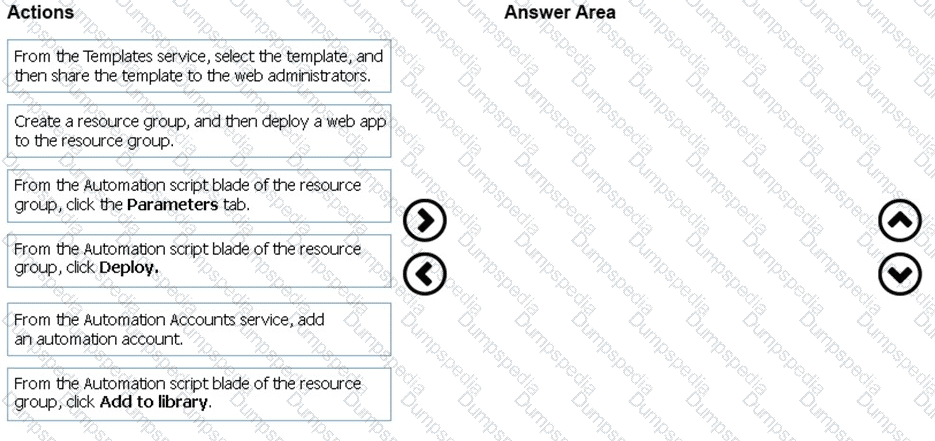You need to identify which storage account to use for the flow logging of IP traffic from VM5. The solution must meet the retention requirements.
Which storage account should you identify?
You need to configure WebApp1 to meet the technical requirements.
Which certificate can you use from Vault1?
You need to implement the planned changes for DCR1. Which type of query should you use?
You need to implement the planned changes for the storage account content. Which containers and file shares can you use to organize the content?
You need to recommend an identify solution that meets the technical requirements.
What should you recommend?
You need to ensure that you can grant Group4 Azure RBAC read-only permissions to all the A2ure file shares. What should you do?
You are planning the move of App1 to Azure.
You create a network security group (NSG).
You need to recommend a solution to provide users with access to App1.
What should you recommend?
You implement the planned changes for NSG1 and NSG2.
For each of the following statements, select Yes if the statement is true. Otherwise, select No.
NOTE: Each correct selection is worth one point.

You need to configure Azure Backup to back up the file shares and virtual machines.
What is the minimum number of Recovery Services vaults and backup policies you should create? To answer, select the appropriate options in the answer area.
NOTE: Each correct selection is worth one point.
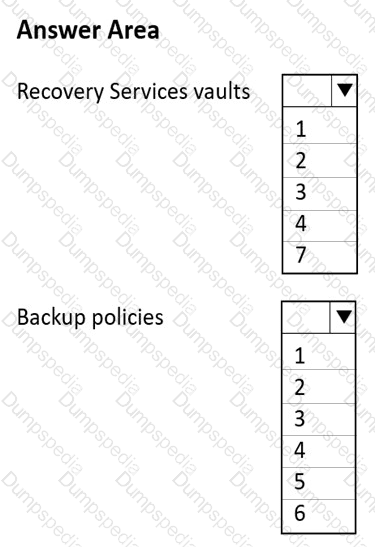
You need to ensure that User1 can create initiative definitions, and User4 can assign initiatives to RG2. The solution must meet the technical requirements.
Which role should you assign to each user? To answer, select the appropriate options in the answer area.
NOTE: Each correct selection is worth one point.
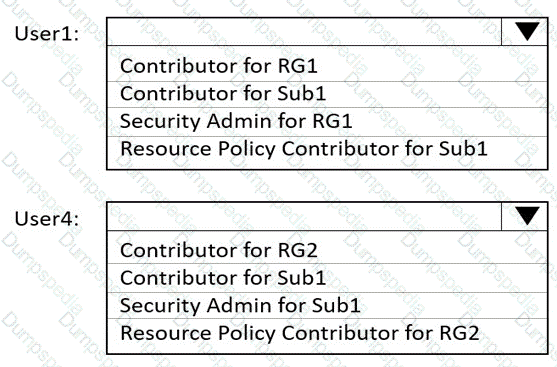
You need to recommend a solution for App1. The solution must meet the technical requirements. What should you include in the recommendation? To answer, select the appropriate options in the answer area.
NOTE: Each correct selection is worth one point.

You need to identify the storage requirements for Contoso.
For each of the following statements, select Yes if the statement is true. Otherwise, select No.
NOTE: Each correct selection is worth one point.

You implement the planned changes for NSG1 and NSG2.
For each of the following statements, select Yes if the statement is true. Otherwise, select No.
NOTE: Each correct selection is worth one point.

You need to configure the alerts for VM1 and VM2 to meet the technical requirements.
Which three actions should you perform in sequence? To answer, move all actions from the list of actions to the answer area and arrange them in the correct order.

You implement the planned changes for cont2.
What is the maximum number of additional access policies you can create for cont2? To answer, select the appropriate options in the answer area.
NOTE: Each correct selection is worth one point.
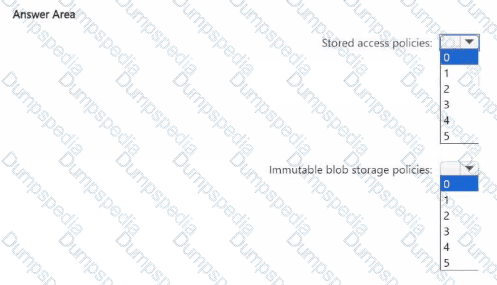
You implement the planned changes for Scope1.
You need to ensure that Scope1 meets the technical requirements.
What can you encrypt by using Scope1?
You need to implement the planned changes for the new containers.
Which Azure services can you use for each image? To answer, select the appropriate options in the answer area.
NOTE: Each correct selection is worth one point.
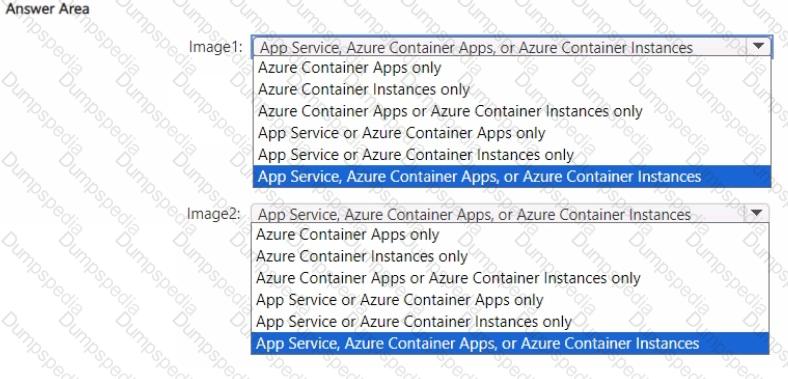
You need to configure Azure Backup to meet the technical requirements for cont1 and share1.
To what should you set the backup frequency for each resource? To answer, select the appropriate options in the answer area.
NOTE: Each correct selection is worth one point.
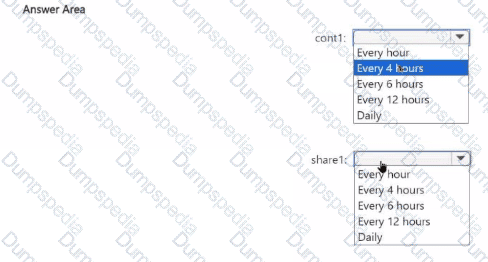
You need to configure encryption for the virtual machines. The solution must meet the technical requirements.
Which virtual machines can you encrypt?
You need to ensure that VM1 can communicate with VM4. The solution must minimize administrative effort.
What should you do?
You need to meet the connection requirements for the New York office.
What should you do? To answer, select the appropriate options in the answer area.
NOTE: Each correct selection is worth one point.

You need to the appropriate sizes for the Azure virtual for Server2.
What should you do? To answer, select the appropriate options in the answer area.
NOTE: Each correct selection is worth one point.
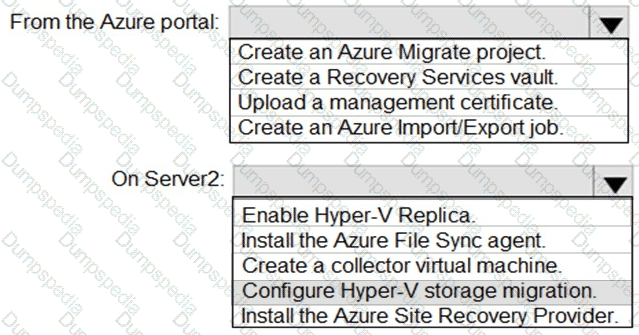
You need to implement Role1.
Which command should you run before you create Role1? To answer, select the appropriate options in the answer area.
NOTE: Each correct selection is worth one point.

You need to recommend a solution to automate the configuration for the finance department users. The solution must meet the technical requirements.
What should you include in the recommended?
You plan to deploy an Azure container instance by using the following Azure Resource Manager template.
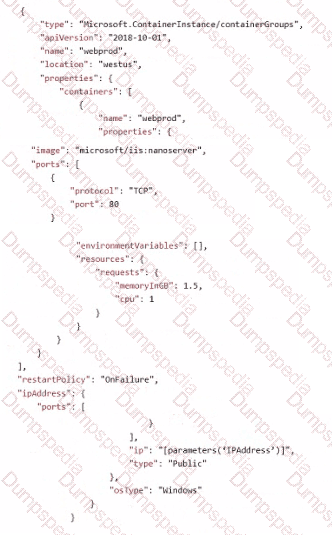
Use the drop-down menus to select the answer choice that completes each statement based on the information presented in the template.

You need to meet the technical requirement for VM4.
What should you create and configure?
You discover that VM3 does NOT meet the technical requirements.
You need to verify whether the issue relates to the NSGs.
What should you use?
You have an Azure subscription.
You plan to use an Azure Resource Manager template to deploy a virtual network named VNET1 that will use Azure Bastion.
How should you complete the template? To answer, select the appropriate options in the answer area.
NOTE: Each correct selection is worth one point.
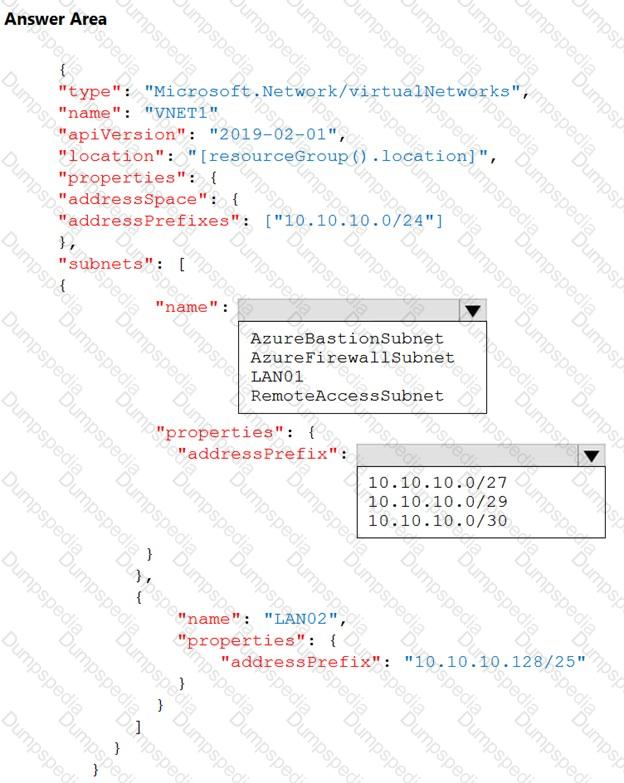
You have an Azure subscription that contains a resource group named RG26.
RG26 is sot to the West Europe location and is used to create temporary resources for a project. RG26 contains the resources shown in the following table.

SQLD01 is backed up to RGV1.
When the project is complete, you attempt to delete RG26 from the Azure portal. The deletion fails.
You need to delete RG26.
What should you do first?
Note: This question is part of a series of questions that present the same scenario. Each question in the series contains a unique solution that might meet the stated goals. Some question sets might have more than one correct solution, while others might not have a correct solution.
After you answer a question in this section, you will NOT be able to return to it. As a result, these questions will not appear in the review screen.
You need to ensure that an Azure Active Directory (Azure AD) user named Admin1 is assigned the required role to enable Traffic Analytics for an Azure subscription.
Solution: You assign the Owner role at the subscription level to Admin1.
Does this meet the goal?
You have an Azure subscription that contains a storage account named storage1. The storage 1 account contains a container named containet1.
You create a blob lifecycle rule named rule1.
You need to configure rule1 to automatically move blobs that were NOT updated for 45 days Irom container! to the Cool access tier.
How should you complete the rule? To answer, select Ihe appropriate options in the answer area.
NOTE: Each correct answer is worth one point.

You have an Azure subscription that contains the virtual networks shown in the following table.

The subscription contains the subnets shown in the following table.

The subscription contains the storage accounts shown in the following table.

You create a service endpoint policy named policy1 in the South Central US Azure region to allow connectivity to all the storage accounts in the subscription.
Few each of the following statements, select Yes if the statement is true. Otherwise, select No.
NOTE: Each correct selection is worth one point.

You have an Azure Storage account named storage1 that contains a blob container named containers You need to prevent new content added to container! from being modified for one year. What should you configure?
You plan to move a distributed on-premises app named App1 to an Azure subscription.
After the planned move, App1 will be hosted on several Azure virtual machines.
You need to ensure that App1 always runs on at least eight virtual machines during planned Azure maintenance.
What should you create?
You have an Azure subscription that contains the storage accounts shown in the following table.
You plan to use AzCopy to copy a blob from contained directly to share. You need to identify which authentication method to use when you use AzCopy.
What should you identify for each account? To answer, drag the appropriate authentication methods to the correct accounts. Each method may be used once, more than once, or not at all. You may need to drag the split bar between panes or scroll to view content.
NOTE: Each correct selection is worth one point.

You have an Azure subscription. The subscription contains a storage account named storage1 that has the lifecycle management rules shown in the following table.

On June 1, you store two blobs in storage1 as shown in the following table.

For each of the following statements, select Yes if the statement is true. Otherwise, select No.
NOTE: Each correct selection is worth one point.

You have an Azure subscription that has a Recovery Services vault named Vault 1. The subscription contains the virtual machines shown in the following table.

You plan to schedule backups to occur every night at 23:00.
Which virtual machines can you back up by using Azure Backup?
You need to define a custom domain name for Azure AD to support the planned infrastructure.
Which domain name should you use?
You need to resolve the licensing issue before you attempt to assign the license again.
What should you do?
You are evaluating the connectivity between the virtual machines after the planned implementation of the Azure networking infrastructure.
For each of the following statements, select Yes if the statement is true. Otherwise, select No.
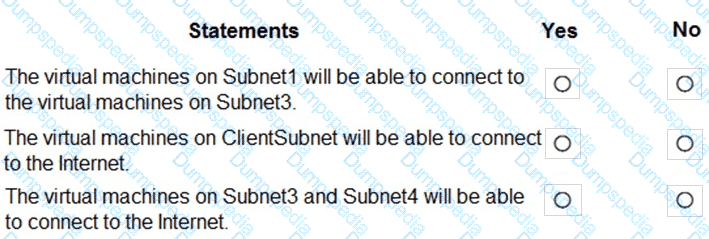
You need to prepare the environment to meet the authentication requirements.
Which two actions should you perform? Each correct answer presents part of the solution.
NOTE: Each correct selection is worth one point.
You are evaluating the name resolution for the virtual machines after the planned implementation of the Azure networking infrastructure.
For each of the following statements, select Yes if the statement is true. Otherwise, select No.

You need to prepare the environment to meet the authentication requirements.
Which two actions should you perform? Each correct answer presents part of the solution.
NOTE Each correct selection is worth one point.
You need to define a custom domain name for Azure AD to support the planned infrastructure.
Which domain name should you use?
You need to prepare the environment to ensure that the web administrators can deploy the web apps as quickly as possible.
Which three actions should you perform in sequence? To answer, move the appropriate actions from the list of actions to the answer area and arrange them in the correct order.
